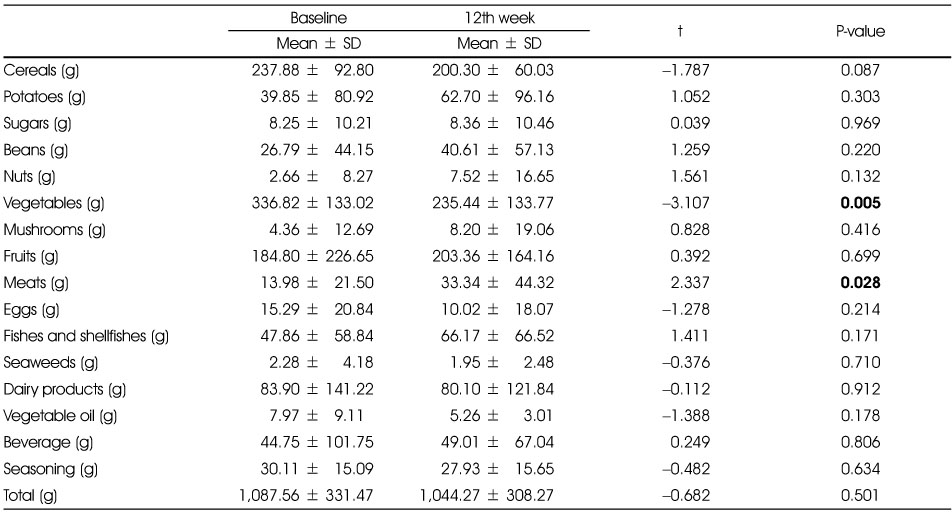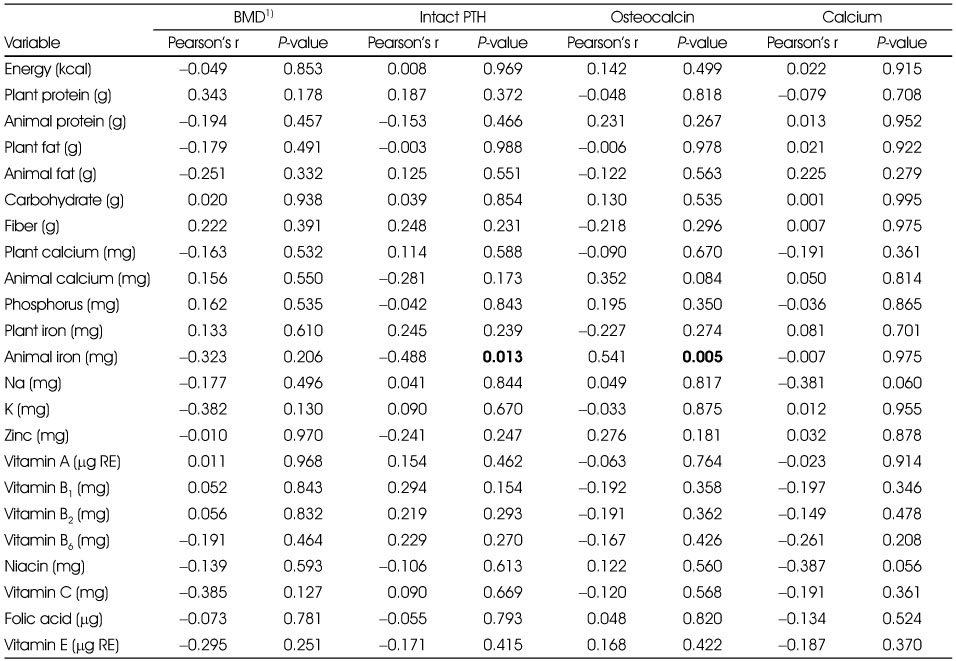Articles
- Page Path
- HOME > Korean J Community Nutr > Volume 18(3); 2013 > Article
-
Original Article
- The Association between Changes in Food and Nutrient Intakes and Changes in Bone Metabolic Indicators in Postmenopausal Women with Osteopenia after a 12-week Intervention of Nutrition Education and Aerobic Exercise
- Seo-Jin Kim, Suh-Jung Kang, Yoon Jung Park, Ji-Yun Hwang
-
Korean Journal of Community Nutrition 2013;18(3):213-222.
DOI: https://doi.org/10.5720/kjcn.2013.18.3.213
Published online: June 30, 2013
Department of Foodservice Management and Nutrition, Sangmyung University, Seoul, Korea.
1Department of Sports Science, Sangmyung University, Seoul, Korea.
2Department of Nutrition Science and Food Management, Ewha Womans University, Seoul, Korea.
3Nutrition Education Major, Graduate School of Education, Sangmyung University, Seoul, Korea.
- Corresponding author: Ji-Yun Hwang, Nutrition Education Major, Graduate School of Education, Sangmyung University, 7 Hongji-dong, Jongno-gu, Seoul 110-743, Korea. Tel: (02) 781-7521, Fax: (02) 2287-0104, jiyunhk@smu.ac.kr
Copyright © 2013 The Korean Society of Community Nutrition
This is an Open-Access article distributed under the terms of the Creative Commons Attribution Non-Commercial License (http://creativecommons.org/licenses/by-nc/3.0/) which permits unrestricted non-commercial use, distribution, and reproduction in any medium, provided the original work is properly cited.
- 928 Views
- 1 Download
- 1 Crossref
Abstract
- Few studies investigated the effects of nutrition education and exercises in women with osteopenia. This study examined the relationship between changes in dietary intakes and changes in indicators related to bone health in postmenopausal women with osteopenia (-2.5 ≤ T-score ≤ 1) after a 12-week intervention. Thirty-one postmenopausal women aged > 50 years residing in Seoul were recruited and participated in nutritional education regarding bone health and general nutrition practices and aerobic exercises (three times a week; 60 min per session). Twenty-five subjects completed the study and were eligible for the analysis. Bone mineral density (BMD) at femoral neck was measured by dual energy x-ray absorptiometry. Serum calcium, osteocalcin, and intact parathyroid hormone (PTH) were also measured. Dietary intake was estimated by using a one-day 24 recall by a clinical dietitian. After 12 weeks, meat consumption increased (P = 0.028) but vegetable intake decreased (P = 0.005). Intakes of animal protein (P = 0.024), vitamin B1 (P = 0.012) and vitamin B2 (P = 0.047) increased, and sodium intake decreased (P = 0.033). Intact PTH (P = 0.002) decreased and osteocalcin (P = 0.000) increased, however, BMD decreased (P = 0.000). Changes in mushroom consumption were positively correlated with femoral neck BMD (r = 0.673, P = 0.003). Changes in animal iron intake were negatively correlated with intact PTH (r = -0.488, P = 0.013) but were positively correlated with osteocalcin (r = 0.541, P = 0.005). These results suggested that the association between animal iron intake and biochemical markers of bone turnover may play an important role in bone metabolism. Further studies are needed to shed light on complicated mechanisms of diet, hormonal levels of bone metabolism, and bone density.
- 1. Akesson K, Vergnaud PH, Delmas PD. Serum osteocalcin increases during fracture healing in elderly women with hip fractures. Bone 1995; 16: 427-430.PubMed
- 2. Campos MS, Barrionuevo M, Alférez MJ, Gómez-Ayala AE, Rodríguez-Matas MC, Lopez Aliaga I, Lisbona F. Interactions among iron, calcium, phosphorus and magnesium in the nutritionally iron-deficient rat. Exp Physiol 1998; 83(6): 771-781.ArticlePubMed
- 3. Choi MJ. Effects of nutrient intake and exercise on bone mineral density and bone mineral density in premenopausal women. Korean J Nutr 2002; 35(4): 437-479.
- 4. Choi YH, Sung CJ. A study on nutrient intakes and serum levels of copper, zinc and manganese in Korean postmenopausal women with different bone mineral density. Korean J Nutr 2006; 39(5): 485-493.
- 5. Chung HY. Osteoporosis diagnosis and treatment 2007. J Korean Endocr Soc 2008; 23(2): 76-108.Article
- 6. Contento IR. Nutrition education - linking research, theory, and practice. Jones & Bartlett Publishers; 2010. p. 114-146.
- 7. Delmas PD. Biochemical markers of bone turnover: methodology and clinical use in osteoporosis. Am J Med 1991; 91(5B): 59S-63S.ArticlePubMed
- 8. Delmas PD, Stenner HW, Wahner KG. Increase in serum bone gamma-carboxyglutamic acid protein with aging in women. J Clin Invest 1983; 71: 1316-1321.ArticlePubMedPMC
- 9. Evans CE, Chughtai AY, Blumsohn A, Giles M, Eastell R. : The effect of dietary sodium on calcium metabolism in premenopausal and postmenopausal women. Eur J Clin Nutr 1997; 51(6): 394-399.ArticlePubMedPDF
- 10. Garnero P, Sornay-Rendu E, Claustrat B, Delmas PD. Biochemical markers of bone turnover, endogenous hormones and the risk of fractures in postmenopausal women: the OFELY study. J Bone Miner Res 2000; 15(8): 1526-1536.ArticlePubMedPDF
- 11. Harris MM, Houtkooper LB, Stanford VA, Parkhill C, Weber JL, Flint-Wagner H, Weiss L, Going SB, Lohman TG. Dietary iron is associated with bone mineral density in healthy postmenopausal women. J Nutr 2003; 133(11): 3598-3602.ArticlePubMed
- 12. Khosla S, Atkinson EJ, Melton LJ 3rd, Riggs BL. Effects of age and estrogen status on serum parathyroid hormone levels and biochemical markers of bone turnover in women: a population-based study. J Clin Endocrinol Metab 1997; 82(5): 1522-1527.ArticlePubMed
- 13. Kim JH, Choi-Kwon S, Park YH, Park KA, Suh MH, Lee SO. The effect of the dietary approaches to stop hypertension (DASH) diet education program on bone mineral density in the middle-aged women: a pilot study. J Korean Biol Nurs Sci 2010; 12(3): 195-205.
- 14. Kim JM, Jin MR, Kim HW, Chang NS. Associations between daily food and nutrient intake and bone mineral density in men aged 50 years and older. Korean J Nutr 2011a; 44(5): 394-405.Article
- 15. Kim KJ, Kim KK, Hwang IC, Lee KS, Suh HS. The relation of plasma osteocalcin and BMI in subjects who visited a health promotion center of a general hospital. Korean J Obes 2011b; 20(2): 51-58.Article
- 16. Kim MS, Choi MS, Kim KN. Effect of nutritional education and exercise intervention on reducing and maintaining weight in obese women. Korean J Community Nutr 2007; 12(1): 80-89.
- 17. Korean Dietetic Association. Manual of medical nutrition therapy. 3rd Edition. Seoul, Korea: Korean Dietetic Association; 2008.
- 18. Korean Nutrition Society. Dietary reference intake for Korean. Seoul, Korea: Korean Nutrition Society; 2010.
- 19. Lee HJ, Lee HO. A study on the bone mineral density and related factors in Korean postmenopausal women. Korean J Nutr 1999; 32(2): 197-203.
- 20. Ministry of Health, Welfare and Family Affairs & Korea Centers for Disease Control and Prevention. 2011 national health statistics - the 5th Korea national health and nutrition examination survey, The second year. Seoul, Korea: Korea Centers for Disease Control and Prevention; 2012.
- 21. Neer RM, Arnaud CD, Zanchetta JR, Prince R, Gaich GA, Reginster JY, Hodsman AB, Eriksen EF, Ish-Shalom S, Genant HK, Wang O, Mitlak BH. Effect of parathyroid hormone (1-34) on fractures and bone mineral density in postmenopausal women with osteoporosis. N Engl J Med 2001; 344(19): 1434-1441.Article
- 22. Oh SY, Kim EM, Shin MH, Lee SH, Kim JE, Lee HS, Jo JS, Kim WY. Development and validity of food frequency questionnaire for adults. Proceedings of the Annual Spring Conference. Seoul, Korea: The Korean Society of Health Promotion; 2007.
- 23. Park J, Choi M, Lee S, Choi Y, Park Y. The association between bone mineral density, bone turnover markers and nutrient intake in pre- and postmenopausal women. Korean J Nutr 2011; 44(1): 29-40.Article
- 24. Park MJ. Association of bone mineral density with nutrient intake and lifestyles of postmenopausal women in Chungnam. J Korean Home Econ Assoc 2005; 43(12): 61-78.
- 25. Peterson BA, Klesges RC, Kaufman EM, Cooper TV, Vukadinovich CM. The effects of an educational intervention on calcium intake and bone mineral content in young women with low calcium intake. Am J Health Promot 2000; 14(3): 149-156.ArticlePDF
- 26. Katsumata S, Tsuboi R, Uehara M, Suzuki K. Dietary iron deficiency decreases serum osteocalcin concentration and bonemineral density in rats. Biosci Biotechnol Biochem 2006; 70(10): 2547-2550.Article
- 27. Steingrimsdottir L, Gunnarsson O, Indridason OS, Franzson L, Sigurdsson G. Relationship between serum parathyroid hormone levels, vitamin D sufficiency, and calcium intake. JAMA 2005; 294(18): 2336-2341.Article
- 28. Tartibian B, Maleki BH, Kanaley J, Sadeghi K. Long-term aerobic exercise and omega-3 supplementation modulate osteoporosis through inflammatory mechanisms in post-menopausal women: a randomized, repeated measures study. Nutr Metab (Lond) 2011; 8: 71.ArticlePDF
- 29. Välimäki VV, Alfthan H, Lehmuskallio E, Löyttyniemi E, Sahi T, Suominen H, Välimäki MJ. Risk factors for clinical stress fractures in male military recruits: a prospective cohort study. Bone 2005; 37(2): 267-273.Article
- 30. Wayne PM, Kiel DP, Buring JE, Connors EM, Bonato P, Yeh GY, Cohen CJ, Mancinelli C, Davis RB. Impact of Tai Chi exercise on multiple fracture-related risk factors in postmenopausal osteopenic women: a pilot pragmatic, randomized trial. BMC Complement Altern Med 2012; 12: 7.ArticlePDF
- 31. World Health Organization. The world health report. Geneva, Switzland: 1998.
- 32. Yeon JY, Sung CJ. A study on dietary mineral intakes, urinary mineral excretions, and bone mineral density in Koreanpostmenopausal women. Korean J Community Nutr 2011; 16(5): 569-579.Article
REFERENCES

1) Dietary quality was assessed by Mini Dietary Assessment (Oh et al. 2007)

1) The proportion of subject whose intake was less than the Korean estimated energy requirements for females in her age (Korean Nutrition Society 2010).
2) The proportion of subject whose intake of both animal and plant sources was less than the Korean estimated average requirements for females in her age (Korean Nutrition Society 2010).
3) The proportion of subject whose intake was less than the Korean estimated average requirements for females in her age (Korean Nutrition Society 2010).
1),2),3) Statistical tests to examine differences in frequencies before and after intervention were not conducted (expected frequencies < 5)
Figure & Data
REFERENCES
Citations

- A Comparison of Salty Taste Assessment, Dietary Attitude and Dietary Behavior among Adult and Senior Women by Region and by Age in Korea
Lin Jiang, Yun-Young Jung, Hyung-Sook Kim, Gi-Seon Nam, Jin-Sook Yun, Jong-Wook Kim, Yeon-Kyung Lee
Korean Journal of Community Nutrition.2015; 20(2): 109. CrossRef
Nutrition education program for bone health
Age and anthropometrics, indicators related to bone mineral density (BMD), and dietary behaviors related to bone health from baseline to follow-up in subjects with osteopenia (n = 25)
1) Dietary quality was assessed by Mini Dietary Assessment (Oh et al. 2007)
Food group intake from baseline to follow-up in subjects with osteopenia (n = 25)
Nutrient intake from baseline to follow-up in subjects with osteopenia (n = 25)
1) The proportion of subject whose intake was less than the Korean estimated energy requirements for females in her age (Korean Nutrition Society 2010).
2) The proportion of subject whose intake of both animal and plant sources was less than the Korean estimated average requirements for females in her age (Korean Nutrition Society 2010).
3) The proportion of subject whose intake was less than the Korean estimated average requirements for females in her age (Korean Nutrition Society 2010).
1),2),3) Statistical tests to examine differences in frequencies before and after intervention were not conducted (expected frequencies < 5)
Correlation between food group intakes change and change of indicators related to bone mineral density(BMD) (n = 25)
1) Data were available for 21 subjects.
Correlation between nutrient intakes change and change of indicators related to bone mineral density(BMD)
1) Data were available for 21 subjects.
1) Dietary quality was assessed by Mini Dietary Assessment (
1) The proportion of subject whose intake was less than the Korean estimated energy requirements for females in her age (Korean Nutrition Society 2010). 2) The proportion of subject whose intake of both animal and plant sources was less than the Korean estimated average requirements for females in her age (Korean Nutrition Society 2010). 3) The proportion of subject whose intake was less than the Korean estimated average requirements for females in her age (Korean Nutrition Society 2010). 1),2),3) Statistical tests to examine differences in frequencies before and after intervention were not conducted (expected frequencies < 5)
1) Data were available for 21 subjects.
1) Data were available for 21 subjects.

 KSCN
KSCN




 Cite
Cite


